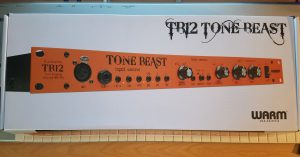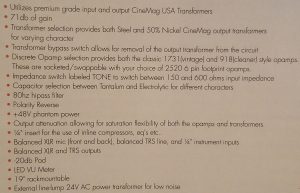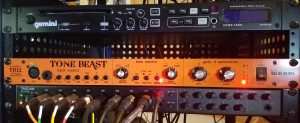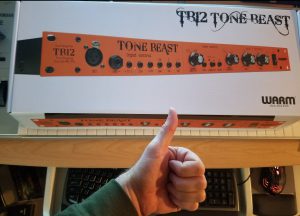
Below my studio… where right now the Warm Audio TB12 mic pre is glowing warmly… is an art gallery.
It’s strewn across the walls of our Master Bedroom downstairs.
The various masterpieces have a plethora of themes, imagery and names:
“Frog Dissection With Worm and Bone”.
“Vortex Birthday”.
“Drago Lava Showers in Wishbone Glade”.
“Mellow Marshie and His Bouncing Arm”.
All of them are classics.
Why?
Because all of them were done… by my kids! Before they were 10!!
How many thousands of these masterpieces have been brought to light due to the rainbow wonders of their ever-ready box of 152 crayons?
Could such brilliant life glimpses have ever materialized without that magic colorful case??
Nay, say I! No way.
So, in the same vein, when you find a piece of studio gear that is as creative and versatile as Crayola’s world, what should you do??
You buy it, dude!!
Warm Audio’s TB12 “ToneBeast” Microphone Preamplifier is exactly that kind of wonderful, and today we shall look up close and personal at how it performs in the studio and catch of glimpse of what the color of fun sounds like.
Let’s do this!
Picture This: An Amp In November…
So what W.A. set out to do was take some of the best vintage components of the past, put ’em in one unit, and add additional parameters that provide versatility beyond what the original legends did not have. In this unit they installed the famed Jensen 918 op amp for clean but strong signal transparency and the esteemed 1731 op amp from Melcor that appeared in the 60s for other hues and tones that present a more ‘vintage’ timbre. Both these components have for decades provided the oomph needed to make countless hit records. Now we get it too, but with more!

The unit’s basic architecture is based on API’s classic 312, which has helped to shape the sound of American classic rock music for decades. Like the 312, the TB12 has strong midrange which delivers a strong pronounced sound for whatever you feed into it. Many are saying this is a monster for rock vocals, and I’d have to say I see what they mean, but if you need the softer, cleaner side it has that too, tho’ not as pristine as, say, a Grace Audio piece.
It’s fall here in Michigan so as a November treat I have picked this beauty up to help me track some edgier stuff that I want to have ready for the new year. So far… this thing is delivering the goods with diversity like the color spectrum. Couldn’t be happier.
Riiiiiii – co – laaaaaaa….
I’ve never worked with a mic pre that is such a Swiss army knife of possibilities. There are a lot of component options in this here orange box, and whatever notch on the gamut you want to cut or boost, with the TB12 you will find the appropriate subtle or conspicuous option that will take you right there.
There are dozens of ways of toning and shaping your signals in this thing, and I can see years of pleasure ahead, trying out new combinations with new clients, new voices, different instrument decisions. It really is like the Ultimate Crayon Case, and did I mention… I love to draw!
Fuzzy Wuzzy Waz An… Amp
Probably the most pronounced circuit is the one attached to the “Gain” knob. Wow, does that thing snarl! It is the least subtle parameter on board; if you want some serious saturation effects for, say, electric guitar or bass, you will find it here in spades. I found plenty for me even at only halfway dialed in.
We’re not talkin’ digital distortion here; rather, the usable, desirable kind, from early Clapton-y type distortion all the way to obvious rock out fuzz. Can’t wait to add some to my “Van Halen-y” songs!
The output pot makes sure you can turn down the extra dB that the Gain knob produces so you can keep the good distortion you’ve dialed in at the preamp stage without any digital clip nastiness. Very intuitive layout; simple and effective. With this kind of setup, thinking of it like a subtle guitar amp would be too far afield.
Warm Audio’s unit is so versatile, in fact, that some engineers are using the TB12 simply as a saturation generator, for sound designing and as an effects insert during mixdown.
It’s the Little Things…

W.A. made sure they used only quality components in the TB12’s construction so this unit could still be giving you stand-out recordings for years if not decades to come. Good to know they’re lookin’ out for us engineers that don’t have a multi-million dollar budget. Thanks, Warm!
Another notch in their versatility belt comes from the fact that they included two insert ports on the back of this unit. So if you want to insert a compressor or EQ in between the op-amps (where your desired tone is created) and the output transformers (which increase or decrease the level to where you want it) you can do so. I personally wouldn’t do any EQ-ing up front since the unit has its own high-pass filter, but I definitely would try throwing an 1176 on there for some subtle awesome compression while recording. Better than a kick in the head, right?!
Okay, here’s a little favorite thing of mine about the unit that I wish all modules and outboard gear had: Each button has its own red LED status light. What’s the big deal with that? I’ll tell you: when I’m singing at the mic or across the room for any reason I an immediately know what I have engaged on this unit with just a glance. Those little lights ROCK!
My other favorite thing? The two transformer options. They really provide such different, obvious shades of useful coloring that it sends the adaptability quotient of this piece right through Wonka’s glass ceiling! My favorite is… well, I’ll tell you soon. 😉
Price
Those that know gear, not only today’s but yesterday’s vintage options, have pretty much unanimously agreed that to get this much versatility AND this high quality of components in one unit at this price is surprising. We all would expect to pay more for what the TB12 offers. Yet another reason why I had serious G.A.S for it for months!
The next best unit that allows this kind of tonal flexibility is the Universal Audio 710 Twin Finity preamp, but the price difference is significant: the 710 retails for $799, as opposed to the TB12’s $599.
Session files
So, as usual here on SeriousG.A.S., I have recorded bits of our theme song with the TB12 with its parameters set differently with each pass. This way you can hear exactly how each engaged circuit manipulates the sound. For the best results, as always, play these files through a great pair of mix headphones or through some high quality studio monitors.

First off, let’s listen to the many different ways a lead vocal can sound through this beauty. The parameter change sequence is as follows:
- D.I. of the Aston Spirit mic, bypassing the TB12 altogether
- x731, bypassed, 10 a.m.
- x731, HPF, bypassed, 10 a.m.
- x731, bypassed, 9 a.m., GAIN 12
- x18, bypassed, 10 a.m.
- x18, bypassed, 10 a.m., TONE
- x18, bypassed, 10 a.m. Cln Cpctr
- x18, UNbypassed, STEEL, 9 a.m.
- x18, UNbypassed, NICKEL, 9 a.m.
- x18, UNbypassed, STEEL, 8:30 a.m. GAIN 9
Next, here is a solo synth line I put over the verse chords, so we can hear how instruments fare with the parameter changes. The sequence is as follows:
- D.I. to my Tascam I/O, bypassing the TB12 altogether
- Hi-z, PAD, x731,Vntg, Bypassed, noon
- Hi-z, Pad, x731,Cln, Bypassed, noon
- Hi-z, Pad, x18,Cln, Bypassed, noon
- Hi-z, Pad, x18,TONE, Cln, Bypassed, noon
- Hi-z, Pad, x18, VNTG, Bypassed, noon
- Hi-z, Pad, x18, CLN, STEEL, noon
- Hi-z, Pad, x18, Cln, NICKEL, noon
- Hi-z, Pad, x731, TONE, VNTG, STEEL, GAIN11,OUT10
Could you hear the differences?? I definitely could, sitting here in front of my Event studio monitors. Even engaging the Capacitor Switch that they said would be so subtle made a noticeable change in certain frequencies.
My favorite for the voice would probably be take 8. So rich, thick and chocolaty – YUMMMMM!!
For the synth, it really depends on what else is in the mix, but hearing it alone I do like take 7. If I decided to change the production and rock the song up a bit take 9 added that little bite to the timbre that would be appropriate, since on that take I dialed the saturation up nicely.
Play, Buy, Play!
Well, I hope you enjoyed that very detailed look into one of the best mic pre options out there right now. I doubt you’ll enjoy it as much as I did RECORDING it, but… I’m sure the joy comes through. ;-0
To sum it all up, I have to say that I hesitate looking at the TB12 as just a mic pre. You can effect sound through this piece to such varying degrees that its almost an effects unit, tho’ not quite.
If you want a clean, clear and transparent mic pre that doesn’t color your sound at all, you can get that by engaging the “Clean” capacitor setting and leaving the rest alone. But if you want to color your sound, to whatever degree you desire, then you’re going to LOVE this mic pre. It has incredible sonic variety, as you’ve heard now in the files.

I personally can’t find any negatives about this unit. Online I only found one complaint, from a guy who didn’t like that the LED level meter was way too bright.
Uh, ok.
Since my racks are to my left and right under my recording desk it doesn’t bother me in the slightest. I suppose, though, if you’re going to have it right in front of your face it might be an issue. Do lights bother you? Didn’t think so.
Thanks again to David Borovoy in the Pro Audio department of Guitar Center, Southfield. Where would my G.A.S. be without him?!!
Final word? Get this mic pre. You won’t be sorry and we can swap pre settings. What could be better?!
Now, go… make… sounds!!
Teaj

Ahhh, Leigh… it sounds like the tentacles of G.A.S. have embraced you! lol
The TB12 will improve your sax sound without question, mostly because it will give you NUMEROUS sax sounds for recordings. I know I can’t wait to blow my soprano through it!
For Black Friday insight, check out the post I wrote here.
Do you have recording software yet of any kind??
This is so entertaining you are funny and fun with how you present your point and ideas. Made me smile. It is difficult to buy an instrument let alone doing it on black Friday and surviving the ordeal. Enjoyed the recordings as well. you are very creative. I will be back for more. I just bought my first mixer and mic for my alto saxophone and it’s been a fun ride so far. so much more to do.